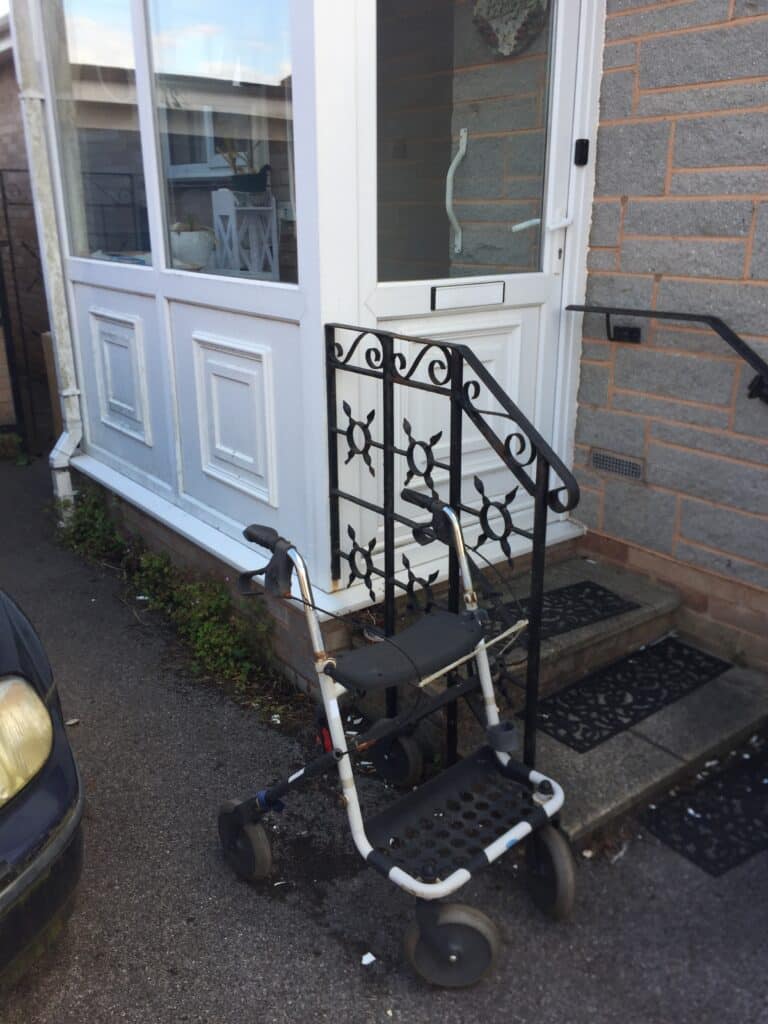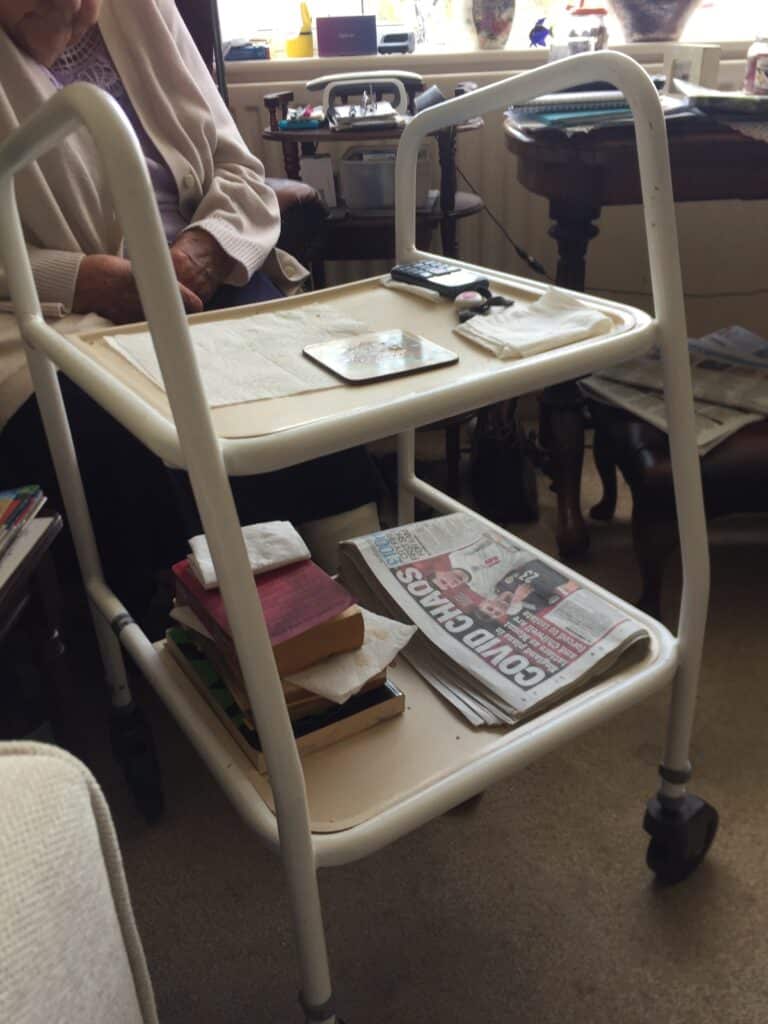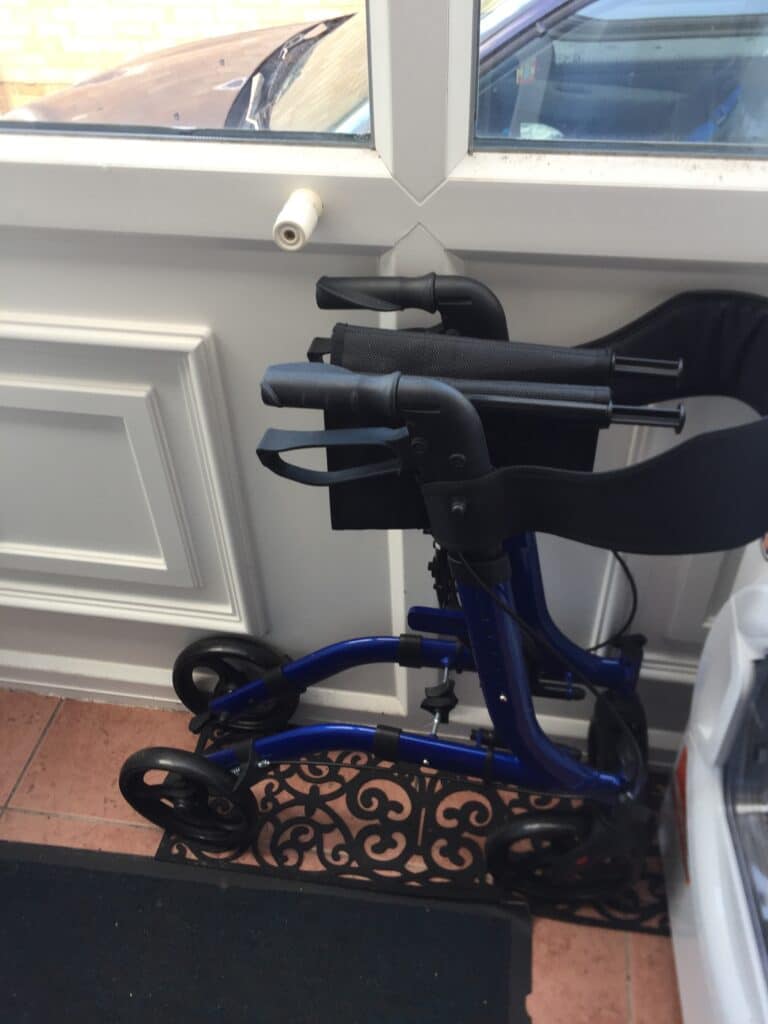Walkers, Stumblers & Fallers
By Andy Cripps •
Image used with the kind permission of William Wegman.
Andy Cripps observes some addressable issues to fundamentally improve the design of walkers through the Hamlyn Walker Challenge, and invites readers to share their stories about living with and using walkers and rollators



Over the past 6 or 7 years, my 89-year-old Mother has become increasingly dependent on her walkers and rollators. She cannot stand unaided for very long now, or walk without one and they enable her to be independently mobile around her house for the whole day.
“These things are everywhere. Why can’t we just have one?” – Dora Cripps
There are three currently at her house – all four wheeled (pictured above). One is of welded steel construction. This is her reliable (though heavy) all day indoor choice – and the other two are aluminium ones that fold. One of these is now little used and stays outside, on the drive. It was used originally for gardening and car trips but a newer, lighter one that folds more easily and compactly has displaced it. This third and newest lives behind the front door. Whoever is accompanying her outside can pick it up and take it down the two steps, allowing her to navigate from her front door to the car door. It then gets folded away and stored in the car boot for use again at the destination.
“I hate using the frame but I can’t really manage without it.”
She undoubtedly relies upon these products and wouldn’t be mobile without them. The indoor frame also doubles up as a side table, dining table, laundry and coffee transporter through the home! But having spent time with her daily at home recently, it is clear to me, at even the most rudimentary observation level, that these products have serious issues.
“A huge help but certainly not to be trusted.”
When standing up, or sitting down, the frame has a tendency to move at exactly the moment an immovable, stable support is crucial. Despite the four wheels, the frame needs to be lifted over thresholds and over any small change of floor level – from carpet to wooden flooring in the kitchen doorway for instance. It is almost impossible to move it one handed – when seated securely and wanting it out of the way – perhaps in the bathroom or kitchen.
The last fall my Mother had was just prior to lockdown. This resulted in a five day hospitalisation, badly gashed legs and hands and a loss of confidence and was in part caused by her frame. Clearing up after dinner, she turned a little too quickly away from the fridge – which caused her arthritic knee to collapse and, as she grabbed at the frame for support, it moved away from her and she fell.
“I’m vulnerable when I’m walking around.”
Research has found that these types of products are used in the home by over 20% of older adults and outdoors by over 40%. This research also shows that many other people who would benefit from their use feel the products are stigmatising and stay clear of them. Perhaps they prefer to use a more elegant walking stick, or pair of sticks.
https://www.youtube.com/watch?v=ki0stxmkeKk&t=3s
“A product of aspiration not desperation.”
– Peter Gore, Professor of Practice in Ageing & Vitality, Newcastle University.
If the functionality is questionable, why hasn’t there been more attention given to the way these products look? To the way that they make people feel? Do product manufacturers in this market assume that, once a person requires a walking aid, their previous life experience and the joy associated with owning and using good looking and well designed products ceases to matter? A lifetime choosing products and furniture within the home, selected with care and consideration goes completely out the window and they have to put up with bland, functionally styled – though arguably not functionally fit for purpose – products.
Having become aware of the walker – and the challenges – a quick internet search reveals a wide range of products – at a wide range of prices too! (From £29 – £1,000) Some are starting to incorporate – or offer as accessories – things like drinks holders, mobile phone holders, handbag clips, removable trays or shopping bags. Some even have colour choices.
The Hamlyn Walker Challenge
The Helen Hamlyn Centre for Design has been in existence since 1991 and this year celebrates its 30th anniversary. It is part of the Royal College of Art in London, a 180-year-old post graduate art and design university – the oldest in the world and regularly voted No 1 art and design university in the world. The Helen Hamlyn Centre for Design is a global leader in Inclusive Design, Design Thinking and creative leadership, working with government, business, academia and the third sector to make life better for all through design. At the inaugural public event of the recently established Design Age Institute, our patron Lady Hamlyn set The Hamlyn Walker Challenge, to fundamentally improve the design of these walkers.
To fully understand the wider background and issues of these devices and the people who use them, we want to hear your stories about using walkers and rollators – or being in the same house as a user. What is good about them – what is bad or dangerous? What could be improved in your opinion? This could be a little tweak to improve daily use – or a wild idea to radically change them. Do you like to customise them yourself either for function, or looks?
Please get in touch – your stories and experience can really help us to improve this product.
We want to design and develop a new walker, or rollator, to create a product that people aspire to use, not one chosen out of desperation at a time of crisis. With your help, we want to design a product that is useful, reliable, beautiful and above all safe to use.
If you are reading this and know that you have some valuable insights and experience to share we would love to hear from you!
Please get in touch with us at the Design Age Institute: DAI-HHCD@rca.ac.uk
More Information
Please get in touch with the Design Age Institute: DAI-HHCD@rca.ac.uk
Sign up here to hear more about the Hamlyn Walker Challenge.
Omhu, a design company who made stylish canes and other mobility aids commissioned photographer William Wegman to produce images of their solutions – and the mobility they provided – in a fun and joyful way.